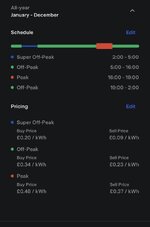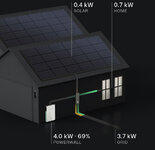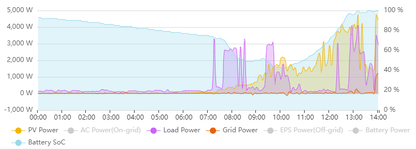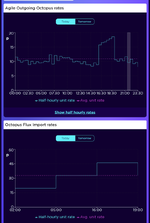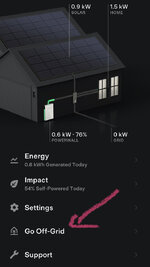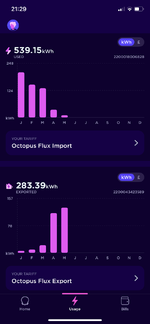My Tesla Energy Tariff has come to an end and the scheme is being discontinued. 12p import and export was too good to be true in our current energy market.
Octopus are pushing users to the new Octopus Flux option: https://octopus.energy/smart/flux/
For my postcode the figures look like this:
Vs the standard flex options
I was talking with @Biff about this so thought it worth sharing here.
The thing I noticed for Flex is that if you fill your battery during the off-peak cheap time, and then have to export all your solar generation (because your battery is full), you would be roughly equal, as the import would be for 20.39 and the export for 22.98p during the day rate. Even with 10 losses from conversion, the figures are near equal. So you don't have to worry about how much you charge up in the morning based on how much expect sun etc. Easy.
I then ran the maths on an average day in April, March, Feb and Jan and found that the cost between the standard Flex pricing and the Flux are largely similar for my usage. They were slightly worse off for Flux when there was no solar but we are talking +-4%. This is doing nothing else in the configuration or changing any habits.
This is about how much energy I use over the day, verse how much I use during peak for cooking/washing machine etc. The oven is used but many other hungry devices are used during the day and take advantage of the same day rate as I would have had on the standard Flex.
When I had solar in March and April, I started to see a better advantage from the better export cost of 22.98 (flux) vs 4.1 (flex), which tipped it in favour of Flex.
But with some setting for powerwall, I can charge up off peak, hold it during the day (no consequences as export from solar is cost neutral) and then sell during peak, so say I do 10kW, that becomes +161.9p for the day trade. Now sometimes, I might want to cook a bit more and use that, so I might have to buy some units or have less to sell.
Plus, many days, I can still be generating electricity from solar during the peak rate export (16:00-19:00), so more than just the 10kW is available for export.
So overall, I am better off. Easy.
Finally, I can set other things to do their tasks during off-peak and make some small gains. Like heat up the log cabin before working from home. NAS backups. A scheduled washing machine tasks. Rinse hold for when we get up a few hours later.
Overall, for my usage, I don't think we there are many days where we going to be much worse off., with most days being much better. I may make some changes to avoid the peak period costs, but these can be insignificant. So very little effort required.
More panels on the West side of the house might be a [/FONT]worthwhile
Octopus are pushing users to the new Octopus Flux option: https://octopus.energy/smart/flux/
For my postcode the figures look like this:
| Import | Export | |
| Day rate | 33.98p / kWh | 22.98p / kWh |
| Flux rate (02:00 - 05:00) | 20.39p / kWh | 9.39p / kWh |
| Peak rate (16:00 - 19:00) | 47.58p / kWh | 36.58p / kWh |
| Standing charge | 42.01p / day |
Vs the standard flex options
| Import | Export | |
| 33.98 | 4.1 | |
| Standing charge | 40p / day |
I was talking with @Biff about this so thought it worth sharing here.
The thing I noticed for Flex is that if you fill your battery during the off-peak cheap time, and then have to export all your solar generation (because your battery is full), you would be roughly equal, as the import would be for 20.39 and the export for 22.98p during the day rate. Even with 10 losses from conversion, the figures are near equal. So you don't have to worry about how much you charge up in the morning based on how much expect sun etc. Easy.
I then ran the maths on an average day in April, March, Feb and Jan and found that the cost between the standard Flex pricing and the Flux are largely similar for my usage. They were slightly worse off for Flux when there was no solar but we are talking +-4%. This is doing nothing else in the configuration or changing any habits.
This is about how much energy I use over the day, verse how much I use during peak for cooking/washing machine etc. The oven is used but many other hungry devices are used during the day and take advantage of the same day rate as I would have had on the standard Flex.
When I had solar in March and April, I started to see a better advantage from the better export cost of 22.98 (flux) vs 4.1 (flex), which tipped it in favour of Flex.
But with some setting for powerwall, I can charge up off peak, hold it during the day (no consequences as export from solar is cost neutral) and then sell during peak, so say I do 10kW, that becomes +161.9p for the day trade. Now sometimes, I might want to cook a bit more and use that, so I might have to buy some units or have less to sell.
Plus, many days, I can still be generating electricity from solar during the peak rate export (16:00-19:00), so more than just the 10kW is available for export.
So overall, I am better off. Easy.
Finally, I can set other things to do their tasks during off-peak and make some small gains. Like heat up the log cabin before working from home. NAS backups. A scheduled washing machine tasks. Rinse hold for when we get up a few hours later.
Overall, for my usage, I don't think we there are many days where we going to be much worse off., with most days being much better. I may make some changes to avoid the peak period costs, but these can be insignificant. So very little effort required.
More panels on the West side of the house might be a [/FONT]worthwhile
Last edited:

